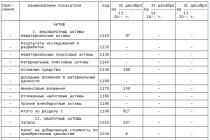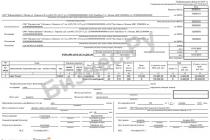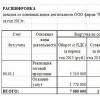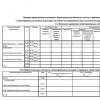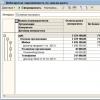Materials at the enterprise are objects of the real world that can be seen, touched. The assignment of objects to the name materials occurs according to the role that the objects perform for a particular enterprise. There are only two roles:
- items involved in the production of products
- items that support the management activities of the entire company
If we think a little, we will find that there is rarely a company that does not have materials in its activities.
For example . Take any firm, no matter what it does. Doesn't she use paper to print various documents, contracts? Doesn't he use household chemicals to keep his offices clean? All this and much more applies to the management of the company. And this means that any company already has a “Materials Accounting” section in its accounting.
Another example . Take enterprises that have production or perform work, for example, an agricultural producer. There you can easily find a considerable amount of different materials. Its main materials will be various seeds, fertilizers. There are also special equipment from such firms; fuel for it, various spare parts. Do not forget about stationery, household chemicals.
How about a bakery? The materials will be - flour, eggs, milk, spices, butter, margarine. Various spare parts for production units, company vehicles. And all the same stationery, household chemicals, etc.
And if we take a construction company...?
Account for accounting materials in accounting - 10 "Materials"
According to accounting rules, information about materials is recorded on account 10.
Information about materials includes 4 main information:
- specific name of the material,
- a place of storage within the company, in other words - a storage warehouse
- quantity of each specific material
- the total amount of each specific material
This information can be found by looking at the settings of the chart of accounts in the accounting program 1C Accounting.
By default, all information about the activities of the company in accounting is expressed in amounts. This follows from the very definition of accounting.
A tick in the K (count) column means that the accounting of the material, in addition to the amount, is still carried out in quantity.
The name “Nomenclature” in the Subconto1 column means that when working with materials, we are required to indicate the specific name of the material. The reference book “Nomenclature” is responsible for storing all the names of materials in the 1C program.
The name “Warehouses” in the Subconto2 column means that we must indicate the location where our material is stored. A list of all the names of storage locations is contained in the "Warehouses" directory.
And with the letter "A" we will meet a little later in this article.
Materials or, a more complete name, Inventory Stocks (IPZ) at certain enterprises reach several thousand items. This is typical for manufacturing companies.
Also, in accounting, a classification of materials according to the group “economic content” was introduced. It is clearly visible if we look at the entire account 10 and its sub-accounts.
![]()
Each sub-account is designed to group certain types of materials.
Sub-account 10.1 “Raw materials and materials” takes into account two types of materials:
- materials that have not been industrially processed. For example: milk, seeds, ore, gas - everything that nature gives
- industrially processed materials. For example: sugar, sunflower oil. The peculiarity of these materials is that they are the final and ready-to-use product.
Sub-account 10.2 “Purchased semi-finished products…” . These are items that, in relation to the production of the company, have not yet been embodied in the final finished product. Such materials are called semi-finished products. In addition, semi-finished products can be of their own production. For example: yeast dough, which we can buy for baking, or we can prepare it ourselves for future baking of our confectionery.
Subaccount 10.2 “Fuel” , subaccount 10.4 “Containers and packaging materials”, subaccount 10.5 “Spare parts”, subaccount 10.8 “Building materials”, subaccount 10.9 “Inventory and household supplies” - speak for themselves.
Sub-account 10.6 “Other materials” just suitable for materials intended for company management: stationery.
Sub-account 10.7 “Materials transferred for processing” - special. It is used for tolling production. The essence of such production is that our company itself does not produce products, or a certain type of product, but transfers it to a third-party company. A third-party company produces products for us from our own materials. This sub-account will take into account those materials that we will give to a third-party company.
Accounting for materials in accounting: examples and postings
Materials accounting involves the interaction of the “materials area” with other areas of accounting. Each accounting area is designated by a specific accounting account. Therefore, our material section (account 10) will interact with other sections (accounting accounts).
These interactions are not to say that there are a great many, but still quite a lot. I will give the most common accounting accounts with which the 10 “Materials” account interacts and for which transactions are generated.
They can safely be attributed to:
- account 10 “Materials”. Yes, yes, I was not mistaken. We can move materials around warehouses, can't we?
- account 20 "Main production",
- account 25 “General production expenses”
- account 26 “General expenses”
- account 60 “Mutual settlements with suppliers”
- accounting account 71 “Settlements with accountable persons”
- accounting account 76 “Settlements with different debtors and creditors” (rarely)
- account 91 “Other income and expenses” (rarely)
The main situations (events) of enterprises, where the material section is involved looks like this:
- Receipt of materials (IPZ)
- Receipt of materials (MPZ) according to the advance report
- Movement of inventories in warehouses
- Transfer of materials to production
- Write-off of materials
- Realization of materials (not typical, rare event for materials)
SPECIAL MOMENT. There is another important material issue to consider. The question itself is the situation, what should we do in accounting if we buy the same material, but suppliers have different prices for it?
First answer option is that we will have to create a new card in the “Nomenclature” directory for each material with a new price. In this case, the list will contain materials with the same names, and sometimes it happens that there are quite a few of them. But that is not all. At the time of transfer to production, for example, 50 pieces of a particular material, we will be forced to select the same material from the list in order to collect 50 pieces in total. This is inconvenient and time consuming.
Second answer option is that we use one card of the material, and the price on account 10 would be the average for each material. The average price formula looks like this.
AveragePrice = (Cost of all quantities of one material) / (Sum of all quantities of one material)
Along with the average price, there are two more types of inventory cost accounting:
FIFO. The first batch came - the first and is spent
LIFO. The last batch came - the first and is spent
These accounts are more difficult to use. However, computer programs take on the complexity of these calculations, and the user is asked to use one card (name) in the reference book.
Examples of material names in accounting in organizations
Look at the names of materials that organizations use in their work. Below I have given fragments of reference books “Nomenclature”. It is clear that the lists are much larger. However, this is enough to see the names of the materials of real enterprises.
Materials "Office" (typical for all firms)
Materials at the dental firm
Materials assigned to the trading floor of the company,
selling medical equipment
Materials “Inventory and household supplies”
(typical for all firms)
(although not all companies need scales for their work :))
Materials “Spare parts for agricultural. enterprises”
Accounting for materials in standard reports
Working with the "Materials" section of the accounting, the results can be quickly viewed in standard accounting reports. The most “running” standard report is the Turnover-Balance-Statement for the account, or in short - “SAL for the account”. This report shows the results in different ways. But most importantly, no more than a characteristic of 10 counts.
OSV on account 10 Materials;
in general, in the context of sub-accounts
OSV on account 10 Materials;
specifically for sub-account 10.1 in the context of “Nomenclature”
Material Accounting - Influence Not Result of Accounting
Accounting materials with all its “major events” and “results in SALT” does not end there. Materials necessarily still appear in the final result of the work of accounting. The results of accounting work include at least two regulated reports:
- “Form No. 1. Balance"
- “Form No. 2. Income statement"
Let's briefly touch on these reports and see where and why the materials appear in them.
Form No. 1 Balance sheet
The balance sheet is a rather large report. In our case, I reduced it as much as possible for clarity.
Look at the line code “12101” and the column “December 31, 2010”. You see the sum 3307214 there. And the line is called “Materials”. But that is not all. Materials are included in the “Current assets” group, and the table itself is called “Asset”.

So we got to the letter "A". Remember I mentioned the letter? In the description of the account, the letter "A" means that the account is active, i.e. the contents of such an account belong to the company, and in the Balance it will fall into a table called “Asset”.
Please note that the “Form No. 1 Balance” contains materials in the total amount from all 10 accounts: there is no division into sub-accounts, warehouses, and even more so, names and quantities. Only general sum accounting.
Form No. 2 Statement of financial results
This regulated report is also large, so I had to extract from it those lines that we need to account for materials.
The name “On financial results” suggests that its main task is to show how much and from what the company has earned or suffered a loss. Those. this report collects information about sales (sales) and expenses incurred from sales (sales).
At the beginning of the article, I talked about events, where I mentioned that there is a sale event for materials, although it is uncharacteristic, because the materials are used for other purposes. And since there are sales of materials, it means that financial results appear. Therefore, the materials are also included in this report.
In our example:
Number 1947
- this is the amount of the sale of materials, which, by the way, belong to the grouping of “other property”.
Number (148)
is the cost of goods sold. The brackets mean that the number 148 is with a minus sign.
The final stage of the work of the chief accountant is an action called “closing the month”. Most of all enterprises perform this action ......
Now we have one of the most extensive and sometimes very complex topics. Perhaps even in five or even ten visits - it is impossible to study it all. Today we are only going to talk about...



